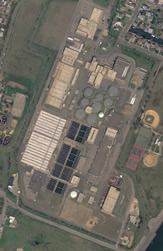- Home
- Departments
- Public Works
- Wastewater Management Program
- Sewage Treatment Master Plan
Sewage Treatment Master Plan
 Wastewater Facilities Planning Guide
Wastewater Facilities Planning Guide
The wastewater facilities currently under the department's jurisdiction, and included in the Sewage Treatment Master Plan, consist of the Bay Park Sewage Treatment Plant, the Cedar Creek Water Pollution Control Plant, and 37 sewage pumping stations throughout the county and the respective sewer areas they serve. When complete, the Master Plan will serve as a valuable planning guide by mapping out a program of capital improvements designed to allow these wastewater facilities to operate reliably and comply with all laws / codes for the next 20-year service period. Work associated with the study is considerable, but can be broken down to nine key tasks:
- Consolidation
- Study / analysis of existing / future wastewater flow / loadings
- Existing facility capacity
- Existing facility condition
- Existing facility performance
- Future regulatory requirements
- Future capacity requirements
- Formation / screening / prioritization of capital alternatives
- Recommending the necessary capital projects and their target implementation schedules
Industry Technology
Included in the capital project development and screening process will be the very latest technology associated with wastewater industry in certain areas, such as advanced treatment (nitrogen reduction), biosolids reclamation / reuse, energy efficiency / recovery (green building designs), odor control, information / data management, safety, security, instrumentation, and more. Such improvements in technology will be valuable in providing the department with these necessary tools to comply with emerging and future regulations geared to enhanced environmental protection (i.e., air, land, water) and public safety / security.
 Consolidation Feasibility Study
Consolidation Feasibility Study
The Consolidation Feasibility Study (CFS) will focus on villages, special districts, and other areas with wastewater facilities currently outside of the county's administrative and operational jurisdiction. This CFS will study such areas to determine the potential benefits to county residents that would be achieved by the consolidation of various wastewater services (i.e., administrative, financial, technical / professional, environmental, etc.) under a larger county entity. The study includes Belgrave, Glen Cove, Port Washington, Oyster Bay, Village of Great Neck, Great Neck Water Pollution Control District, Long Beach, Jones Beach, Lawrence, Cedarhurst, and West Long Beach plants and their sewage collection/ transport facilities.
Negative / Positive Aspects
Any negative impacts would also be listed. All aspects of these facilities (i.e., condition, capital improvement need, efficiency of administration / operation, present and future environmental impacts, etc.) will be evaluated against well-established / published benchmark values within the wastewater industry. Thereafter, a recommendation will be made, on a case-by-case basis, if it is cost effective and environmentally beneficial (over the usual 20-year planning period) to consolidate.
Contact Us
-
Kenneth G Arnold, P.E.
CommissionerDepartment of Public Works
1194 Prospect Avenue
Westbury, NY 11590-2723Illicit Discharges: 516-571-7535
Road Maintenance: 516-571-6900
Traffic Signals: 516-572-0465
Mosquito Control: 516-571-6900
SUEZ Emergency Hotline: 866-224-8508 (For all sewer related issues.)